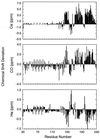Structure of the recombinant full-length hamster prion protein PrP(29-231): the N terminus is highly flexible
- PMID: 9391046
- PMCID: PMC28326
- DOI: 10.1073/pnas.94.25.13452
Structure of the recombinant full-length hamster prion protein PrP(29-231): the N terminus is highly flexible
Abstract
The prion diseases seem to be caused by a conformational change of the prion protein (PrP) from the benign cellular form PrPC to the infectious scrapie form PrPSc; thus, detailed information about PrP structure may provide essential insights into the mechanism by which these diseases develop. In this study, the secondary structure of the recombinant Syrian hamster PrP of residues 29-231 [PrP(29-231)] is investigated by multidimensional heteronuclear NMR. Chemical shift index analysis and nuclear Overhauser effect data show that PrP(29-231) contains three helices and possibly one short beta-strand. Most striking is the random-coil nature of chemical shifts for residues 30-124 in the full-length PrP. Although the secondary structure elements are similar to those found in mouse PrP fragment PrP(121-231), the secondary structure boundaries of PrP(29-231) are different from those in mouse PrP(121-231) but similar to those found in the structure of Syrian hamster PrP(90-231). Comparison of resonance assignments of PrP(29-231) and PrP(90-231) indicates that there may be transient interactions between the additional residues and the structured core. Backbone dynamics studies done by using the heteronuclear [1H]-15N nuclear Overhauser effect indicate that almost half of PrP(29-231), residues 29-124, is highly flexible. This plastic region could feature in the conversion of PrPC to PrPSc by template-assisted formation of beta-structure.
Figures





Comment in
-
The environmental dependency of protein folding best explains prion and amyloid diseases.Proc Natl Acad Sci U S A. 1998 Feb 3;95(3):930-2. doi: 10.1073/pnas.95.3.930. Proc Natl Acad Sci U S A. 1998. PMID: 9448261 Free PMC article. Review. No abstract available.
References
Publication types
MeSH terms
Substances
LinkOut - more resources
Full Text Sources
Other Literature Sources
Research Materials

